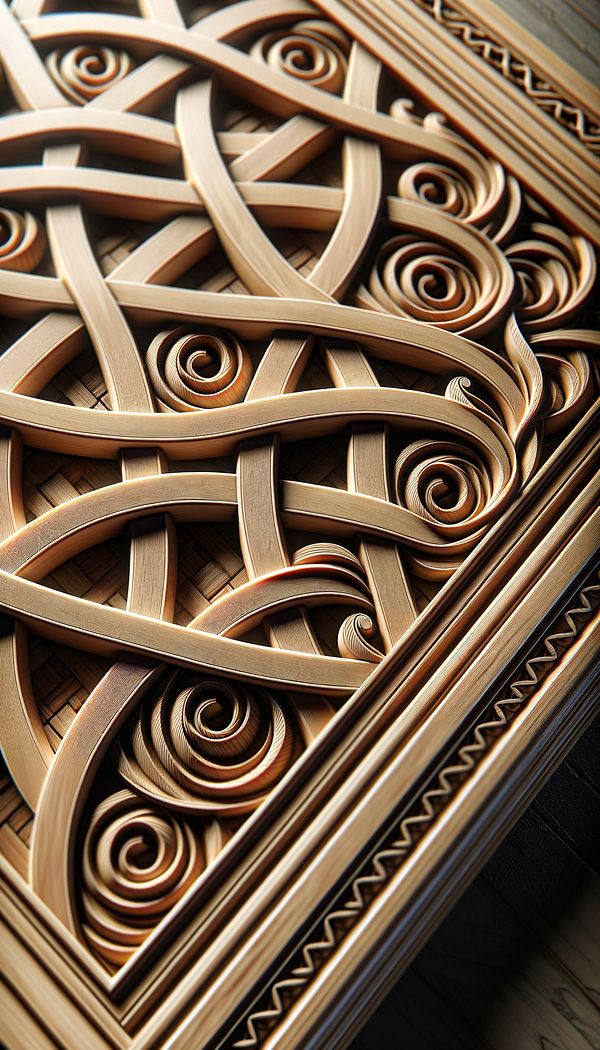What is Strapwork?
Strapwork refers to a decorative motif featuring interlaced straps or bands.
Description
Strapwork is a visually fascinating decorative element that emerged primarily in the Renaissance and gained popularity through the Mannerist and Baroque periods. These intricate patterns are composed of flat strips, resembling leather straps or bands, that weave over and under each other in complex arrangements. They can be purely geometrical in nature or can form more elaborate designs, such as scrolls, foliage, or even fantastical creatures.
The origins of strapwork can be traced back to the revived interest in classical motifs during the Renaissance, alongside the increased capacity for detailed stonework and wood carving. Owing to its flexibility as a design element, strapwork can be found in various aspects of interior design and architecture, from ceiling decorations and wall friezes to furniture details and even fine metalwork.
Its appeal lies in its ability to add depth, texture, and a sense of grandeur to any space. Whether rendered in plaster, carved in wood, or embossed on metal, strapwork brings a layer of sophistication and historical charm. While associated with more traditional designs, it can also complement contemporary spaces when used thoughtfully, serving as a bridge between the old and the new.
Usage
Strapwork is widely used in the design of historic buildings, particularly those from the Renaissance, Mannerist, and Baroque periods. It is commonly seen in elaborate ceiling designs, decorative wall panels, intricate fireplace surrounds, and detailed furniture enhancements. In modern settings, strapwork motifs may be incorporated into wallpaper designs, fabric patterns, or even as decorative elements in metalwork and lighting fixtures.
FAQs
-
How does strapwork contribute to interior design?
Strapwork adds depth, texture, and an element of historical charm to spaces. It introduces intricate patterns that can serve as focal points or complementary details, enhancing the overall aesthetic appeal and grandeur of interior designs.
-
Can strapwork be used in contemporary design?
Yes, while traditionally associated with classical and historical designs, strapwork can be skillfully incorporated into contemporary settings. Modern interpretations often simplify the patterns or use them subtly to add texture and interest without overwhelming the space.
-
What materials are commonly used for strapwork?
Strapwork can be rendered in various materials, including plaster for ceiling and wall decorations, wood for carved furniture and friezes, and metal for intricate hardware and decorative objects. The choice of material often depends on the context and desired effect.
-
Is strapwork suitable for DIY projects?
Strapwork can be complex due to its intricate patterns, making it challenging for DIY projects. However, enthusiasts with advanced skills in woodworking, plastering, or metalworking might undertake such projects. Simpler strapwork-inspired designs could also be achievable for those looking to add a historical touch to their decor.
Practical Application
When incorporating strapwork into a design, consider the scale and context. In a large, grand space, elaborate strapwork can add a level of opulence. In smaller or more modern spaces, opt for simpler designs or use strapwork in subtle ways, such as through hardware details or as a textural element in textiles. It's also important to balance strapwork with the overall design theme to ensure it complements rather than overshadows other elements.
-
Architectural Elements199 articles
-
Design Styles478 articles
-
Furniture Types599 articles
-
Decorative Techniques322 articles
-
Materials & Textiles360 articles
-
FillFill refers to materials used to provide softness, volume, or insulation in interior design elements.
-
FederalFederal refers to an American architectural and interior design style that flourished from roughly 1780 to 1830.
-
TV ArmoireA tall, freestanding cabinet designed specifically to house a television and related media equipment.
-
BoiserieBoiserie is a French term that refers to intricately carved wood paneling used for walls.
-
TabouretA small, often portable stool or seat.
